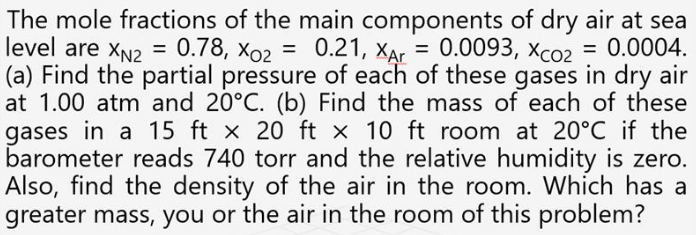The mole fractions of the main components of dry air at sea 0.0093, Xco2 level are xN2 = 0.78, xo2 = 0.21, XAr = = 0.0004. (a) Find the partial pressure of each of these gases in dry air at 1.00 atm and 20°C. (b) Find the mass of each of these gases in a 15 ft x 20 ft × 10 ft room at 20°C if the barometer reads 740 torr and the relative humidity is zero. Also, find the density of the air in the room. Which has a greater mass, you or the air in the room of this problem? %3D
The mole fractions of the main components of dry air at sea 0.0093, Xco2 level are xN2 = 0.78, xo2 = 0.21, XAr = = 0.0004. (a) Find the partial pressure of each of these gases in dry air at 1.00 atm and 20°C. (b) Find the mass of each of these gases in a 15 ft x 20 ft × 10 ft room at 20°C if the barometer reads 740 torr and the relative humidity is zero. Also, find the density of the air in the room. Which has a greater mass, you or the air in the room of this problem? %3D
Introduction to Chemical Engineering Thermodynamics
8th Edition
ISBN:9781259696527
Author:J.M. Smith Termodinamica en ingenieria quimica, Hendrick C Van Ness, Michael Abbott, Mark Swihart
Publisher:J.M. Smith Termodinamica en ingenieria quimica, Hendrick C Van Ness, Michael Abbott, Mark Swihart
Chapter1: Introduction
Section: Chapter Questions
Problem 1.1P
Related questions
Question
please help....

Transcribed Image Text:The mole fractions of the main components of dry air at sea
level are XN2 = 0.78, xo2 = 0.21, XAr = 0.0093, Xco2
(a) Find the partial pressure of each of these gases in dry air
at 1.00 atm and 20°C. (b) Find the mass of each of these
gases in a 15 ft x 20 ft x 10 ft room at 20°C if the
barometer reads 740 torr and the relative humidity is zero.
Also, find the density of the air in the room. Which has a
greater mass, you or the air in the room of this problem?
= 0.0004.
%3D
Expert Solution
Trending now
This is a popular solution!
Step by step
Solved in 9 steps

Knowledge Booster
Learn more about
Need a deep-dive on the concept behind this application? Look no further. Learn more about this topic, chemical-engineering and related others by exploring similar questions and additional content below.Recommended textbooks for you

Introduction to Chemical Engineering Thermodynami…
Chemical Engineering
ISBN:
9781259696527
Author:
J.M. Smith Termodinamica en ingenieria quimica, Hendrick C Van Ness, Michael Abbott, Mark Swihart
Publisher:
McGraw-Hill Education

Elementary Principles of Chemical Processes, Bind…
Chemical Engineering
ISBN:
9781118431221
Author:
Richard M. Felder, Ronald W. Rousseau, Lisa G. Bullard
Publisher:
WILEY

Elements of Chemical Reaction Engineering (5th Ed…
Chemical Engineering
ISBN:
9780133887518
Author:
H. Scott Fogler
Publisher:
Prentice Hall

Introduction to Chemical Engineering Thermodynami…
Chemical Engineering
ISBN:
9781259696527
Author:
J.M. Smith Termodinamica en ingenieria quimica, Hendrick C Van Ness, Michael Abbott, Mark Swihart
Publisher:
McGraw-Hill Education

Elementary Principles of Chemical Processes, Bind…
Chemical Engineering
ISBN:
9781118431221
Author:
Richard M. Felder, Ronald W. Rousseau, Lisa G. Bullard
Publisher:
WILEY

Elements of Chemical Reaction Engineering (5th Ed…
Chemical Engineering
ISBN:
9780133887518
Author:
H. Scott Fogler
Publisher:
Prentice Hall


Industrial Plastics: Theory and Applications
Chemical Engineering
ISBN:
9781285061238
Author:
Lokensgard, Erik
Publisher:
Delmar Cengage Learning

Unit Operations of Chemical Engineering
Chemical Engineering
ISBN:
9780072848236
Author:
Warren McCabe, Julian C. Smith, Peter Harriott
Publisher:
McGraw-Hill Companies, The